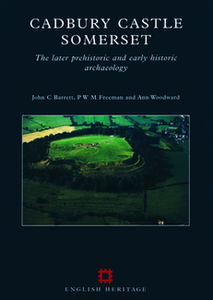English Heritage Archaeological Monographs
English Heritage, 2014. https://doi.org/10.5284/1028203. How to cite using this DOI
Data copyright © English Heritage unless otherwise stated
This work is licensed under the ADS Terms of Use and Access.
Primary contact
Historic England
The Engine House
Firefly Avenue
Swindon
SN2 2EH
Resource identifiers
- ADS Collection: 1416
- DOI:https://doi.org/10.5284/1028203
- How to cite using this DOI
Cadbury Castle Somerset: The later prehistoric and early historic archaeology
Barrett, J., Woodward, A., Freeman, P.
English Heritage (2000)
Abstract:

Some time late in the first century AD, Roman military action took place in the hillfort of Cadbury Castle, Somerset. The evidence for destruction in the south-western gateway includes deposits of fragmentary and partly-burnt human remains, weaponry, and dress fittings. After this destruction, barracks were built on the hilltop. These events effectively brought to an end the history of an indigenous community that, for nearly a millennium before, had settled within and constructed one of the most impressive hillforts in southern Britain. This is a report of the archaeology of that community from its origins in the late Bronze Age to its eclipse in the Roman Iron Age. The archaeological deposits are extensive. The ramparts and south-western gate structure represents one of the deepest and most complex Iron Age stratigraphic sequences excavated in southern Britain, and the survival of preserved surface deposits within the interior yielded a remarkable range of metalworking debris and animal burials. Consequently this report contains a wealth of detail concerning the material culture of what had been a rich and powerful Iron Age community, and its significantly extends our understanding of the nature of hillfort occupation in southern Britain.
Download monograph
| Cadbury Castle Somerset: The later prehistoric and early historic archaeology, Barrett, J.|Woodward, A.|Freeman, P., English Heritage (2000), ISBN: 9781848021808 | 60 Mb |





